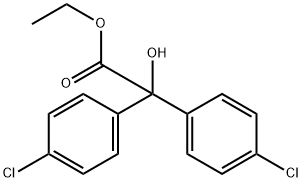CHLOROBENZILATE

- CAS No.
- 510-15-6
- Chemical Name:
- CHLOROBENZILATE
- Synonyms
- g338;Acar;Akar;G 338;G23922;akar50;Folbex;AKAR(R);G 23992;Akar 50
- CBNumber:
- CB1431322
- Molecular Formula:
- C16H14Cl2O3
- Molecular Weight:
- 325.19
- MOL File:
- 510-15-6.mol
- Modify Date:
- 2024/12/18 14:07:02
| Melting point | 37-38℃ |
|---|---|
| Boiling point | bp0.04 146-148° |
| Density | 1.332 |
| refractive index | 1.5727 |
| storage temp. | 0-6°C |
| pka | 11.11±0.29(Predicted) |
| Water Solubility | 13mg/L(20 ºC) |
| Merck | 13,2141 |
| Stability | Stable. Combustible. Incompatible with strong oxidizing agents, strong acids, alkalies, lime. |
| CAS DataBase Reference | 510-15-6(CAS DataBase Reference) |
| IARC | 3 (Vol. 30, Sup 7) 1987 |
| EPA Substance Registry System | Chlorobenzilate (510-15-6) |
SAFETY
Risk and Safety Statements
| Symbol(GHS) |   GHS07,GHS09 |
|---|---|
| Signal word | Warning |
| Hazard statements | H302-H319-H410 |
| Precautionary statements | P264-P270-P273-P280-P301+P312-P305+P351+P338 |
| Hazard Codes | Xn,N,T |
| Risk Statements | 22-50/53-63-43-36/37/38-23/24/25-45-67-40 |
| Safety Statements | 60-61-36/37-24/25-23-53 |
| RIDADR | UN 1593 6.1/PG 3 |
| WGK Germany | 3 |
| RTECS | DD2275000 |
| HS Code | 29181800 |
| Hazardous Substances Data | 510-15-6(Hazardous Substances Data) |
| Toxicity | LD50 in male, female rats (mg/kg): 1040, 1220 orally (Gaines) |
CHLOROBENZILATE Chemical Properties,Uses,Production
Description
Chlorobenzilate is an organochlorine pesticide belonging to the same class as dichlorodiphenyltrichloroethane (DDT). It was originally developed by Ciba–Geigy and introduced in 1952.
Chemical Properties
Ethyl 4,40 -dichlorobenzilate is a yellow solid when pure. The technical product is a brownish liquid.
Uses
The primary use of chlorobenzilate is as an acaricide for mite control on citrus crops and in beehives. It has a narrow insecticidal action, killing only mites and ticks. Historically, chlorobenzilate was used as a synergist for DDT. Although now banned for use in the United States and Europe, it is believed to be used on crops other than citrus in other countries.
General Description
Viscous yellow liquid or pale yellow crystals. Light brown crystalline solid.
Air & Water Reactions
Insoluble in water.
Reactivity Profile
CHLOROBENZILATE is hydrolyzed by alkalis and strong acids. Incompatible with lime .
Health Hazard
Moderately toxic by oral route; toxic symptoms similar to DDT and Perthane; ingestionof large dose can produce nausea, vomiting,tremor and convulsions; skin or eye contactcan cause irritation; application of 25 mgproduced moderate irritation of eye inrabbits; adequate evidence of carcinogenicityin experimental animals; produced tumors inrats and mice; evidence of carcinogenicity inhumans remains unknown.
LD50 oral (rat): 700 mg/kg
LD50 oral (mouse): 729 mg/kg.
Fire Hazard
Flash point data for CHLOROBENZILATE are not available; however, CHLOROBENZILATE is probably combustible.
Safety Profile
Suspected carcinogen with experimental carcinogenic, neoplastigenic, and tumorigenic data. Moderately toxic by ingestion. A skin and eye irritant. A pesticide. When heated to decomposition it emits toxic fumes of Cl-.
Potential Exposure
It is a buffer in many chemical intermediates; an organochlorine miticide; to kill mites, ticks, and other insects; as a synergist for DDT. Incompatibilities: Strong acids, strong bases; lime.
Environmental Fate
Biological. Rhodotorula gracilis, a yeast isolated from an insecticide-treated soil,
degraded chlorobenzilate in a basal medium supplemented by sucrose. Metabolites identified by this decarboxylation process were 4,4′-dichlorobenzilic acid, 4,4′-dichlorobenzophenone and carbon dioxide (Miyazaki et al., 1969, 1970).
Soil. Though no products were identified, the half-life of chlorobenzilate in two fine
sandy soils was estimated to be 1.5–5 weeks (Wheeler, 1973).
Photolytic. Chlorobenzilate should not undergo direct photolysis since it does not
absorb UV light at wavelengths greater than 290 nm (Gore et al., 1971).
Shipping
UN2996 Organochlorine pesticides, liquid, toxic, Hazard Class: 6.1; Labels: 6.1-Poisonous materials.UN2761 Organochlorine pesticides, solid, toxic, Hazard Class: 6.1; Labels: 6.1-Poisonous materials.
Waste Disposal
Consult with environmental regulatory agencies for guidance on acceptable disposal practices. Generators of waste containing this contaminant (≥100 kg/mo) must conform to EPA regulations governing storage, transportation, treatment, and waste disposal. In accordance with 40CFR165, follow recommendations for the disposal of pesticides and pesticide containers. Must be disposed properly by following package label directions or by contacting your local or federal environmental control agency, or by contacting your regional EPA office.
CHLOROBENZILATE Preparation Products And Raw materials
Raw materials
Preparation Products
| Supplier | Tel | Country | ProdList | Advantage | Inquiry |
|---|---|---|---|---|---|
| CLEARSYNTH LABS LTD. | +91-22-45045900 | Hyderabad, India | 6257 | 58 | Inquiry |
| Hebei Chuanghai Biotechnology Co., Ltd | +8615531151365 | China | 18137 | 58 | Inquiry |
| SUZHOU SENFEIDA CHEMICAL CO.,LTD | +86-0512-83500002 +8615195660023 | China | 26362 | 58 | Inquiry |
| Aladdin Scientific | United States | 57505 | 58 | Inquiry | |
| XIAMEN AMITY INDUSTRY AND TRADE CO., LTD. | +8618950047208 | China | 43416 | 58 | Inquiry |
| Chongqing Chemdad Co., Ltd | +86-023-6139-8061 +86-86-13650506873 | China | 39927 | 58 | Inquiry |
| LGC Standards | +44 (0)20 8943 8480 | United Kingdom | 6494 | 0 | Inquiry |
| Shaanxi Didu New Materials Co. Ltd | +86-89586680 +86-13289823923 | China | 8772 | 58 | Inquiry |
| Shanghai Titan Scientific Co.,Ltd | 16621234537 | China | 7702 | 58 | Inquiry |
| Shanghai YuanYe Biotechnology Co., Ltd. | 021-61312847; 18021002903 | China | 71829 | 60 | Inquiry |
Related articles
- Toxicity of Chlorobenzilate
- Chlorobenzilate is an organochlorine pesticide belonging to the same class as dichlorodiphenyltrichloroethane (DDT). It was or....
- Jan 6,2022





